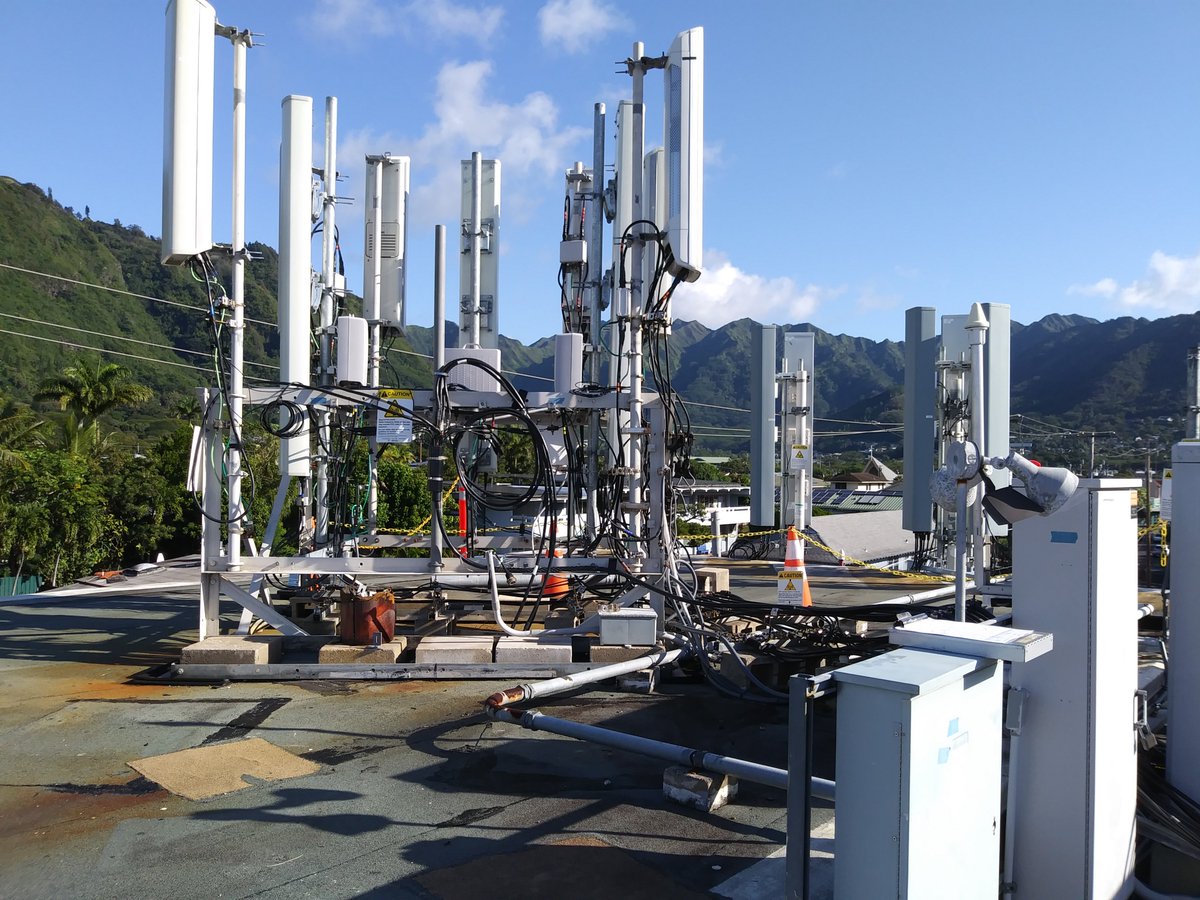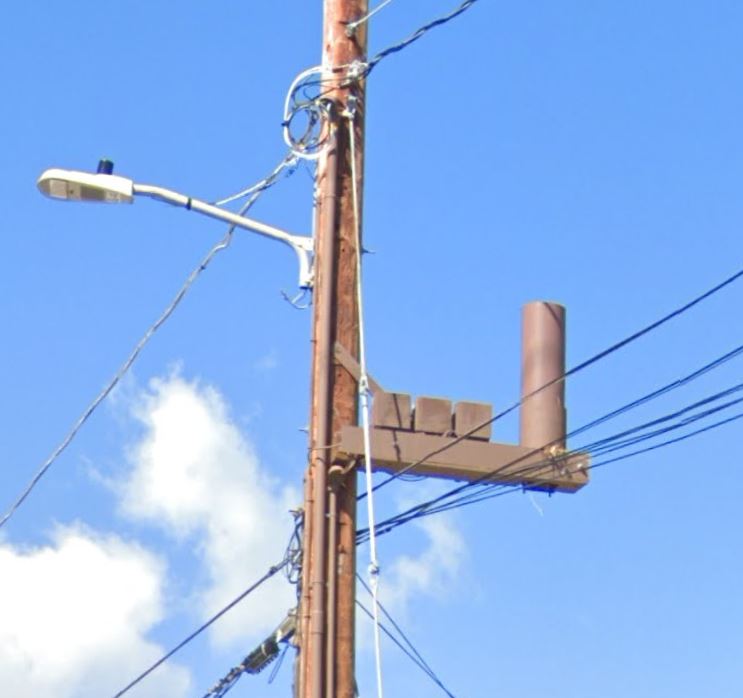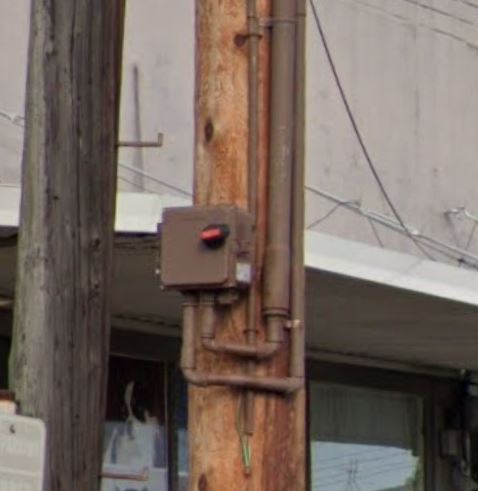5G Millimeter Wave: A thread.
Nearly everything I learned/experienced during my time as the ILEC& #39;s (look up the term if you don& #39;t know) lead outside plant engineer tasked with bringing the "Big 4" cell carriers& #39; 5G nodes online.
Nearly everything I learned/experienced during my time as the ILEC& #39;s (look up the term if you don& #39;t know) lead outside plant engineer tasked with bringing the "Big 4" cell carriers& #39; 5G nodes online.
1) For reference, this is a typical 4GLTE rooftop cell site. Several carriers have antennae at this particular site. These sites are typically anywhere from 50& #39; to 200& #39; off the ground. You also have tower sites, which are pretty easy to spot.
2) Know that most cell sites/towers need to be fed by either copper of fiber optic wire to be able to provide service. This is what the Big 4 buy from ILECs/CLECs. Once the local provider gets the site details from the carrier, we build the wire to the site. Very simple.
3) 5G is different from previous generations (That& #39;s what the "G" stands for), in that it uses millimeter wave technology.
Cell antenna emit radio frequency waves. These waves, of course, have wavelengths. Millimeter wave has a much shorter wavelength than previous gen antennae
Cell antenna emit radio frequency waves. These waves, of course, have wavelengths. Millimeter wave has a much shorter wavelength than previous gen antennae
4) Millimeter wave& #39;s shorter wavelength drastically reduces the range of each antenna. This reduction in range means that more antennae need to be installed to generate adequate coverage. Also, things like buildings, trees, etc can hinder the waves& #39; path.
5) In order for 5G millimeter wave coverage to work, antennae (nodes) need to be placed throughout a city lower to the ground and closer to each other than previous.
Instead of rooftops, some of the Big 4 are placing 5G nodes on street lights and utility poles.
Instead of rooftops, some of the Big 4 are placing 5G nodes on street lights and utility poles.
6) This placement is where the trouble comes from.
First, RF can be dangerous. When you step onto the roof of a 4GLTE site, you see these signs. If you spend enough time next to an active antenna, you will feel the adverse effects.
https://www.fcc.gov/engineering-technology/electromagnetic-compatibility-division/radio-frequency-safety/faq/rf-safety">https://www.fcc.gov/engineeri...
First, RF can be dangerous. When you step onto the roof of a 4GLTE site, you see these signs. If you spend enough time next to an active antenna, you will feel the adverse effects.
https://www.fcc.gov/engineering-technology/electromagnetic-compatibility-division/radio-frequency-safety/faq/rf-safety">https://www.fcc.gov/engineeri...
7) This is a 5G millimeter wave node mounted on a utility pole. Note that the arm the node rests on is about 23& #39; to 24& #39; off the ground. Also note the telcom/CATV wires directly under the node. Also note the distinct lack of any warning/caution signage. This where I came in.
8) 3 prototype nodes were built before I was part of the project. My concern, being a former technician, was the total lack of any new safety protocol for working on utility poles with these nodes. They were expecting linemen, installers, etc to work without regard to the node.
9) This was not standard practice, but the beginning phase of projects like this always have hiccups. I figured this was the best time to iron things out, as every cell carrier would be installing nodes soon, with one pole accommodating one node: These will be everywhere.
10) One of the Big 4 submitted 250 new nodes for approval. This included location, infrastructure build, demarcation point, etc. Typical stuff. I reported back that, while I would examine the infrastructure build, no nodes would be approved until the safety issue was addressed
11) Not an outrageous request. However, no protocol was every produced.
So, I requested that a power shut off switch be installed, so that technicians working on the pole could turn the node off if they needed to work on the pole. They agreed to this. A prototype was built.
So, I requested that a power shut off switch be installed, so that technicians working on the pole could turn the node off if they needed to work on the pole. They agreed to this. A prototype was built.
12) At this point, it was mid 2019. 60+ nodes were to be built by year& #39;s end. It was quite obvious that this would not happen. A lot goes into new protocol: documents need to be made (internal and external), techs need to be trained, etc.
13) While this was being hashed out, I found out that all 250 nodes had been approved by a brand new engineer that had no formal training: they were rubber stamped, no questions asked.
I& #39;m no Luddite and I dislike conspiracy theories, but this move was very shitty.
I& #39;m no Luddite and I dislike conspiracy theories, but this move was very shitty.
14) So, at least here, nodes with shut off switches will be going up, but with no real safety documentation for techs, let alone the public.
In some instances, these nodes will be at eye level of 2 story buildings that happen to be next to a utility pole.
In some instances, these nodes will be at eye level of 2 story buildings that happen to be next to a utility pole.
15) The main points:
a) The nodes, which emit RF, will be closer to the ground i.e. closer to you.
b) There will be many, many more nodes throughout your city than previous.
c) The process to build these nodes, at least here, was rushed and not done properly in terms of safety
a) The nodes, which emit RF, will be closer to the ground i.e. closer to you.
b) There will be many, many more nodes throughout your city than previous.
c) The process to build these nodes, at least here, was rushed and not done properly in terms of safety
16) Some other thoughts:
Telcos do not have infrastructure running to street lights. The cost to build this infrastructure (which is on the telco) is, in some cases, astronomical. This involves tearing up sidewalk, 100s of feet of ug conduit. We aren& #39;t making money here.
Telcos do not have infrastructure running to street lights. The cost to build this infrastructure (which is on the telco) is, in some cases, astronomical. This involves tearing up sidewalk, 100s of feet of ug conduit. We aren& #39;t making money here.
17) Also, in terms of ILECS/CLECS, we are basically helping the Big 4 put us out of business. We are in the business of providing internet: Why help the competition? I have some deeper knowledge of this, but cannot speak on it due to legalities.
18) The rush to bring a new product to market always has some hazards. However, there is something off about the 5G build. My advice to those very concerned:
1) Be aware of utility easements on your property. If anyone can plant a pole there, you can get a 5G node.
1) Be aware of utility easements on your property. If anyone can plant a pole there, you can get a 5G node.
19) 2) Fiber optic is essential to 5G. Copper wire ain& #39;t cuttin& #39; it. If you live in a rural area without fiber, odds are very low money will be spent on fiber and nodes to get it there...currently. Always be aware of Connect America funding in your rural area, though.
20) 3) It doesn& #39;t hurt to petition your government. Street lights usually belong to city and county. They have final say as to what can/cannot go on the lamp. Make some noise if you are concerned.
The utility poles are different. Cash strapped utilities sell out very easily.
The utility poles are different. Cash strapped utilities sell out very easily.
21) Finally, my personal feelings on the matter:
5G is vanity. I believe we are sacrificing health for a luxury item. I enjoy being connected, but not at that price.
Also, I will never discount the idea that 5G *could* be used for nefarious purposes, whatever those may be.
5G is vanity. I believe we are sacrificing health for a luxury item. I enjoy being connected, but not at that price.
Also, I will never discount the idea that 5G *could* be used for nefarious purposes, whatever those may be.

 Read on Twitter
Read on Twitter






